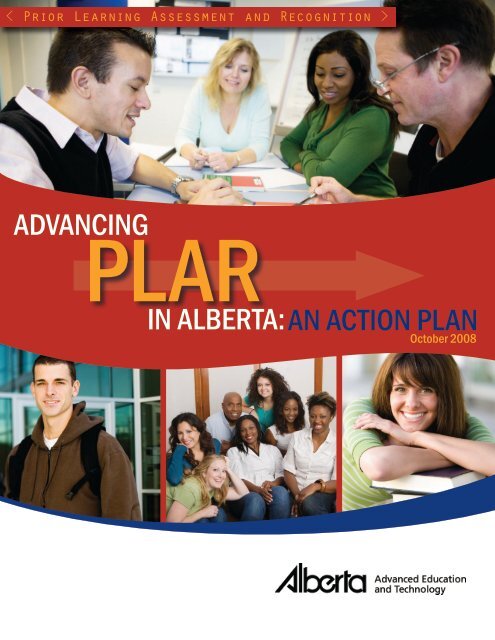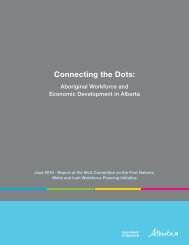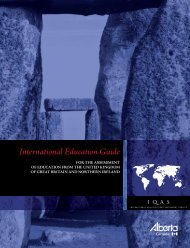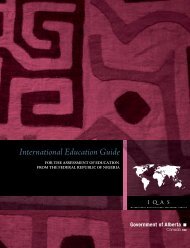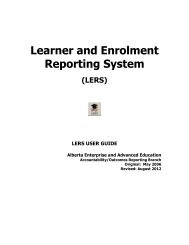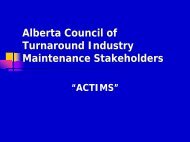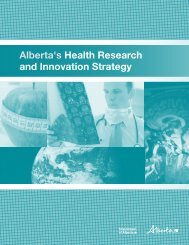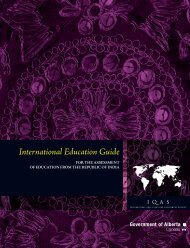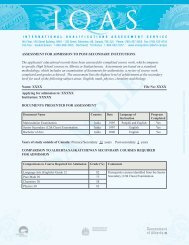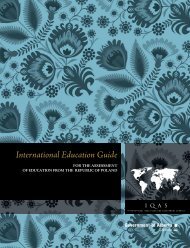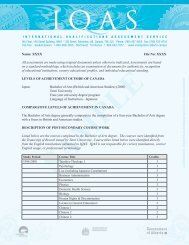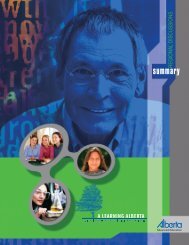Advancing PLAR in Alberta: an Action Plan - Enterprise and ...
Advancing PLAR in Alberta: an Action Plan - Enterprise and ...
Advancing PLAR in Alberta: an Action Plan - Enterprise and ...
- No tags were found...
You also want an ePaper? Increase the reach of your titles
YUMPU automatically turns print PDFs into web optimized ePapers that Google loves.
Scope of <strong>Action</strong> Pl<strong>an</strong>This document outl<strong>in</strong>es <strong>an</strong> <strong>Action</strong> Pl<strong>an</strong> for adv<strong>an</strong>c<strong>in</strong>g <strong>PLAR</strong> <strong>in</strong> <strong>Alberta</strong>. The <strong>Action</strong> Pl<strong>an</strong>provides Adv<strong>an</strong>ced Education <strong>an</strong>d Technology with priority actions to benefit learnersby support<strong>in</strong>g the full potential for <strong>PLAR</strong> <strong>in</strong> the adv<strong>an</strong>ced education system <strong>an</strong>d thecommunity-based adult education system. The <strong>Action</strong> Pl<strong>an</strong> contributes to further<strong>in</strong>g thevision of Campus <strong>Alberta</strong> by encourag<strong>in</strong>g <strong>in</strong>creased access to learn<strong>in</strong>g <strong>an</strong>d collaborationamong learn<strong>in</strong>g providers.The <strong>Action</strong> Pl<strong>an</strong> has as its overarch<strong>in</strong>g goals to:• support a quality, learner-centered system;• foster a culture <strong>in</strong> support of all learn<strong>in</strong>g;• facilitate <strong>an</strong>d enh<strong>an</strong>ce learn<strong>in</strong>g <strong>an</strong>d work tr<strong>an</strong>sitions; <strong>an</strong>d,• <strong>in</strong>crease participation <strong>an</strong>d access to cont<strong>in</strong>uous education, particularly for underrepresentedlearners.This <strong>Action</strong> Pl<strong>an</strong> also identifies a set of outcomes to be achieved, <strong>an</strong>d proposes a number ofactions to implement.The focus of the <strong>Action</strong> Pl<strong>an</strong> is purposefully narrowed to that of the adv<strong>an</strong>ced educationsystem <strong>an</strong>d community-based adult education providers with<strong>in</strong> the m<strong>an</strong>date of Adv<strong>an</strong>cedEducation <strong>an</strong>d Technology. In the future, the scope of the <strong>Action</strong> Pl<strong>an</strong> should be exp<strong>an</strong>ded<strong>an</strong>d aligned with the work of other government departments, <strong>an</strong>d <strong>in</strong> particular with <strong>Alberta</strong>Employment <strong>an</strong>d Immigration’s work on foreign qualification recognition.The development of the <strong>Action</strong> Pl<strong>an</strong> has been <strong>in</strong>formed by feedback solicited from keystakeholders of the adv<strong>an</strong>ced education system <strong>an</strong>d experts <strong>in</strong> the <strong>PLAR</strong> field.5
ADVANCING <strong>PLAR</strong>IN ALBERTA<strong>Action</strong> Pl<strong>an</strong>Goal<strong>Alberta</strong>ns will benefit from greater access to quality prior learn<strong>in</strong>g assessment <strong>an</strong>drecognition practices.This goal recognizes that recognition of previously acquired skills, competencies, <strong>an</strong>dknowledge is a key component of facilitat<strong>in</strong>g cont<strong>in</strong>ued lifelong learn<strong>in</strong>g <strong>an</strong>d work, <strong>an</strong>dfor liv<strong>in</strong>g <strong>in</strong> a healthy <strong>an</strong>d prosperous society.Guid<strong>in</strong>g Pr<strong>in</strong>ciplesThe follow<strong>in</strong>g pr<strong>in</strong>ciples guide the outcomes <strong>an</strong>d actions that will achieve the goal.<strong>PLAR</strong> practices <strong>in</strong> <strong>Alberta</strong> will demonstrate quality <strong>an</strong>d excellence: The identification,assessment, <strong>an</strong>d recognition of <strong>in</strong>dividuals’ skills, competencies <strong>an</strong>d knowledge acquiredthrough formal, <strong>in</strong>formal, non-formal, <strong>an</strong>d experiential learn<strong>in</strong>g should be rigorous <strong>an</strong>dma<strong>in</strong>ta<strong>in</strong> the excellent st<strong>an</strong>dards of <strong>Alberta</strong>’s adv<strong>an</strong>ced education system.<strong>PLAR</strong> practices <strong>in</strong> <strong>Alberta</strong> will be learner-centred: <strong>PLAR</strong> practices should be efficient,relev<strong>an</strong>t, effective <strong>an</strong>d accessible for learners.<strong>PLAR</strong> practices <strong>in</strong> <strong>Alberta</strong> will promote access: Access to <strong>PLAR</strong> should be readily availablethroughout <strong>Alberta</strong>. Such access will <strong>in</strong>crease aspirations for learn<strong>in</strong>g <strong>an</strong>d participation <strong>in</strong>further learn<strong>in</strong>g, particularly for under-represented learners.<strong>PLAR</strong> practices <strong>in</strong> <strong>Alberta</strong> will reflect flexibility: <strong>PLAR</strong> mech<strong>an</strong>isms should be flexible <strong>an</strong>dresponsive to the diverse needs of <strong>in</strong>dividual learners as well as those of <strong>in</strong>stitutions.Such flexibility is designed to accommodate the learner while still ma<strong>in</strong>ta<strong>in</strong><strong>in</strong>g qualityst<strong>an</strong>dards.<strong>PLAR</strong> practices <strong>in</strong> <strong>Alberta</strong> will <strong>in</strong>tegrate <strong>an</strong>d align with <strong>Alberta</strong> systems: Work<strong>in</strong>gcollaboratively, community-based providers, post-secondary <strong>in</strong>stitutions, <strong>in</strong>dustry, <strong>an</strong>dprofessional associations should foster <strong>an</strong> <strong>in</strong>tegrated <strong>an</strong>d responsive learn<strong>in</strong>g culture thatenables tr<strong>an</strong>sitions <strong>in</strong>to <strong>an</strong>d across prov<strong>in</strong>cial learn<strong>in</strong>g systems <strong>an</strong>d <strong>in</strong>to the labour market<strong>an</strong>d portability of learners’ <strong>PLAR</strong> credits.<strong>PLAR</strong> practices <strong>in</strong> <strong>Alberta</strong> will be susta<strong>in</strong>able: Recogniz<strong>in</strong>g previously acquired skills,competencies, <strong>an</strong>d knowledge contributes to <strong>an</strong> affordable educational system byreduc<strong>in</strong>g duplicative learn<strong>in</strong>g <strong>an</strong>d accelerat<strong>in</strong>g completion of studies. Integrat<strong>in</strong>g <strong>PLAR</strong>best practices will ensure cost-effective <strong>an</strong>d stream-l<strong>in</strong>ed educational opportunities forlearners, employers, <strong>an</strong>d <strong>in</strong>stitutions.6
Key OutcomesTo achieve the overarch<strong>in</strong>g goal, four key outcomes for the <strong>Action</strong> Pl<strong>an</strong> have beenidentified.A. Increased Information, Awareness <strong>an</strong>d Support for <strong>PLAR</strong> – to build broad support forvalu<strong>in</strong>g <strong>an</strong>d recogniz<strong>in</strong>g previously acquired skills, competencies, <strong>an</strong>d knowledge, <strong>an</strong>dto raise awareness of the benefits <strong>an</strong>d opportunities of <strong>PLAR</strong> across multiple sectors.B. Quality Assur<strong>an</strong>ce for <strong>PLAR</strong> – to provide clear direction for the development of agreedupon quality assur<strong>an</strong>ce policies, practices <strong>an</strong>d processes for identify<strong>in</strong>g, assess<strong>in</strong>g, <strong>an</strong>drecogniz<strong>in</strong>g previously acquired skills, competencies, <strong>an</strong>d knowledge.C. Increased Capacity of the System to Engage <strong>in</strong> <strong>PLAR</strong> Practices – to enh<strong>an</strong>ce the ability ofcommunity-based learn<strong>in</strong>g org<strong>an</strong>izations <strong>an</strong>d post-secondary <strong>in</strong>stitutions to engage <strong>in</strong><strong>PLAR</strong> practices.D. Connection of <strong>PLAR</strong> Providers <strong>an</strong>d Services – to <strong>in</strong>crease <strong>in</strong>dividuals’ access to learn<strong>in</strong>gopportunities by creat<strong>in</strong>g <strong>an</strong>d strengthen<strong>in</strong>g alignment between <strong>an</strong>d with<strong>in</strong> theadv<strong>an</strong>ced education system, the community adult learn<strong>in</strong>g system <strong>an</strong>d the labourmarket.7
ADVANCING <strong>PLAR</strong>IN ALBERTA<strong>Action</strong> StrategiesThe follow<strong>in</strong>g proposed actions will work to achieve the goal <strong>an</strong>d outcomes identified <strong>in</strong>the <strong>Action</strong> Pl<strong>an</strong> over the next three years <strong>an</strong>d <strong>in</strong>to the longer term. Wherever possible,implementation of the actions will build upon exist<strong>in</strong>g prov<strong>in</strong>cial <strong>an</strong>d national bestpractices <strong>an</strong>d will allow for ongo<strong>in</strong>g stakeholder <strong>in</strong>put.The follow<strong>in</strong>g actions are org<strong>an</strong>ized by the outcome they will fulfill. Under eachaction short <strong>an</strong>d long term activities have been identified. M<strong>an</strong>y of the actions are<strong>in</strong>terdependent <strong>an</strong>d will need to be implemented <strong>in</strong> a coord<strong>in</strong>ated <strong>an</strong>d phased approach.Outcome A: Increased Information, Awareness <strong>an</strong>d Support for<strong>PLAR</strong><strong>Action</strong> #1 – CommunicationDevelop a broad prov<strong>in</strong>cial communication strategy to <strong>in</strong>crease awareness ofthe benefits of identify<strong>in</strong>g, assess<strong>in</strong>g, <strong>an</strong>d recogniz<strong>in</strong>g previously acquired skills,competencies, <strong>an</strong>d knowledge.Short-term activitiesLong-term activities• Initially target communications strategyto post-secondary <strong>in</strong>stitutions <strong>an</strong>dcommunity adult learn<strong>in</strong>g providers toprovide them with <strong>in</strong>formation on <strong>PLAR</strong>,its benefits <strong>an</strong>d the resources available.• Promote <strong>Alberta</strong>’s participation <strong>in</strong><strong>PLAR</strong> <strong>in</strong>itiatives at the national CAPLA(C<strong>an</strong>adi<strong>an</strong> Association for Prior Learn<strong>in</strong>gAssessment) conference <strong>in</strong> B<strong>an</strong>ff fromOctober 19-21, 2008.<strong>Action</strong> #2 – Information• Once quality assur<strong>an</strong>ce practicesare developed (see <strong>Action</strong> #3)<strong>an</strong>d greater capacity for <strong>PLAR</strong> isdeveloped with<strong>in</strong> the adv<strong>an</strong>cededucation system, exp<strong>an</strong>d targetof communications strategy tolearners, employers <strong>an</strong>d the generalpublic.With the support of the <strong>Alberta</strong> Council on Admissions <strong>an</strong>d Tr<strong>an</strong>sfer (ACAT), develop aresource database to <strong>in</strong>crease access to <strong>in</strong>formation on <strong>PLAR</strong>, <strong>in</strong>clud<strong>in</strong>g best practicesprov<strong>in</strong>cially, nationally <strong>an</strong>d <strong>in</strong>ternationally.Short-term activitiesLong-term activities• Develop resource database <strong>an</strong>d house onACAT website.• Conduct research project to update the2005 Best Practices <strong>in</strong> <strong>PLAR</strong> document.• Identify other research projectson best practices that will assistthe adv<strong>an</strong>ced education system <strong>in</strong>provid<strong>in</strong>g high quality <strong>PLAR</strong> serviceto learners.8
<strong>Action</strong> StrategiesOutcome B: Quality Assur<strong>an</strong>ce for <strong>PLAR</strong><strong>Action</strong> #3 – Quality Assur<strong>an</strong>ceWith the support of the <strong>PLAR</strong> Committee <strong>an</strong>d ACAT, support the development of qualityassur<strong>an</strong>ce practices for <strong>PLAR</strong>, <strong>in</strong>clud<strong>in</strong>g quality assur<strong>an</strong>ce practices for identification,assessment, <strong>an</strong>d recognition processes. St<strong>an</strong>dards should build upon national <strong>an</strong>d<strong>in</strong>ternational expertise.Short-term activitiesLong-term activities• Compile <strong>in</strong>formation <strong>an</strong>d <strong>an</strong>alysis onexist<strong>in</strong>g national <strong>an</strong>d <strong>in</strong>ternationalquality assur<strong>an</strong>ce practices <strong>an</strong>d wherenecessary conduct new research.• <strong>PLAR</strong> Committee to lead developmentof quality assur<strong>an</strong>ce practices for <strong>Alberta</strong>(see <strong>Action</strong> #4).• Support <strong>in</strong>creased collaborationwith <strong>in</strong>dustries <strong>an</strong>d professionalorg<strong>an</strong>izations to ensure quality <strong>PLAR</strong>practices are consistent with exist<strong>in</strong>gst<strong>an</strong>dards.• Promote the development <strong>an</strong>d useof quality assessment tools for theadv<strong>an</strong>ced education system to use<strong>in</strong> assess<strong>in</strong>g <strong>an</strong>d award<strong>in</strong>g <strong>PLAR</strong>credit.Outcome C: Increased Capacity of the System to Engage <strong>in</strong> <strong>PLAR</strong>Practices<strong>Action</strong> #4 - Stakeholder CommitteeSupport the implementation of a mech<strong>an</strong>ism to <strong>in</strong>crease capacity of the system toengage <strong>in</strong> <strong>PLAR</strong> practicesShort-term activitiesLong-term activities• Establish a <strong>PLAR</strong> Committeemodeled after ACAT’s articulation<strong>an</strong>d sub-committee structures withrepresentatives from: ACAT, postsecondary<strong>in</strong>stitutions, community adultlearn<strong>in</strong>g providers, government, learners<strong>an</strong>d other stakeholders as identified.<strong>Action</strong> #5 - Professional Development• Support the development of aCampus <strong>Alberta</strong> Prior Learn<strong>in</strong>gAssessment Network (CAPLAN) as <strong>an</strong>etwork<strong>in</strong>g mech<strong>an</strong>ism.Support professional development <strong>an</strong>d tra<strong>in</strong><strong>in</strong>g of staff <strong>an</strong>d volunteers with<strong>in</strong> thecommunity adult learn<strong>in</strong>g system <strong>an</strong>d post-secondary <strong>in</strong>stitutions <strong>in</strong> recognized <strong>PLAR</strong>practices.Short-term activitiesLong-term activities• Deliver tra<strong>in</strong><strong>in</strong>g to a cohort of potential<strong>PLAR</strong> practitioners with<strong>in</strong> the adv<strong>an</strong>cededucation system, with particularemphasis on colleges <strong>an</strong>d communityadult learn<strong>in</strong>g providers <strong>in</strong>itially.• Establish a professionaldevelopment fund to support future<strong>an</strong>d ongo<strong>in</strong>g tra<strong>in</strong><strong>in</strong>g needs.9
ADVANCING <strong>PLAR</strong>IN ALBERTA<strong>Action</strong> StrategiesOutcome C: Increased Capacity of the System to Engage <strong>in</strong> <strong>PLAR</strong>Practices<strong>Action</strong> #6 – Identify<strong>in</strong>g BarriersExam<strong>in</strong>e key fund<strong>in</strong>g issues <strong>an</strong>d other barriers for post-secondary <strong>in</strong>stitutions,community adult learn<strong>in</strong>g providers <strong>an</strong>d learners to fully utiliz<strong>in</strong>g the potential of <strong>PLAR</strong>.Short-term activitiesLong-term activities• With the support of the <strong>PLAR</strong> Committee, • Develop recommendations <strong>an</strong>dACAT <strong>an</strong>d the M<strong>in</strong>istry, identify the key strategies to address <strong>an</strong>d mitigatefund<strong>in</strong>g issues <strong>an</strong>d other barriers (e.g., identified barriers.portability of <strong>PLAR</strong> credits, academiccontrol, faculty workload etc).<strong>Action</strong> #7 –Data <strong>an</strong>d Indicators of SuccessDevelop accountability mech<strong>an</strong>isms to count <strong>an</strong>d track <strong>PLAR</strong> learners <strong>in</strong> the adv<strong>an</strong>cededucation system to document mobility of those learners <strong>an</strong>d document <strong>in</strong>stitutions’ useof award<strong>in</strong>g <strong>PLAR</strong> credits.Short-term activitiesLong-term activities• Us<strong>in</strong>g the <strong>Alberta</strong> Student Number <strong>an</strong>d • Develop new data gather<strong>in</strong>gother exist<strong>in</strong>g data sources, develop a mech<strong>an</strong>isms if needed.data model that will gather current data • Produce report profil<strong>in</strong>g <strong>PLAR</strong><strong>an</strong>d trends on <strong>PLAR</strong> learners.learners <strong>an</strong>d <strong>in</strong>stitution’s use ofaward<strong>in</strong>g <strong>PLAR</strong> credits.• Based on data f<strong>in</strong>d<strong>in</strong>gs, develop<strong>in</strong>dicators to measure success<strong>an</strong>d <strong>an</strong>y recommendations forimprovements.<strong>Action</strong> #8 – Centre of ExcellenceIn alignment with the Roles <strong>an</strong>d M<strong>an</strong>dates Policy Framework, identify a <strong>PLAR</strong> Centreof Excellence with<strong>in</strong> the adv<strong>an</strong>ced education system with a m<strong>an</strong>date to further <strong>PLAR</strong><strong>in</strong> <strong>Alberta</strong>, through such methods as: develop<strong>in</strong>g supports for learners to assist themthrough <strong>PLAR</strong> processes; explor<strong>in</strong>g best practices; conduct<strong>in</strong>g research; portability of<strong>PLAR</strong> credits; <strong>an</strong>d ensur<strong>in</strong>g knowledge tr<strong>an</strong>sfer on <strong>PLAR</strong> practices, issues, policies, <strong>an</strong>dprograms.Short-term activitiesLong-term activities• Def<strong>in</strong>e m<strong>an</strong>date <strong>an</strong>d scope of <strong>PLAR</strong> • Identify <strong>PLAR</strong> Centre of Excellence.Centre of Excellence.• Provide fund<strong>in</strong>g support to the <strong>PLAR</strong>Centre of Excellence to fulfill def<strong>in</strong>edm<strong>an</strong>date.10
<strong>Action</strong> StrategiesOutcome D: Connection of <strong>PLAR</strong> Providers <strong>an</strong>d Services<strong>Action</strong> #9 - Community CapacityIn alignment with Build<strong>in</strong>g Vibr<strong>an</strong>t Learn<strong>in</strong>g Communities <strong>an</strong>d the Literacy <strong>Action</strong> Pl<strong>an</strong>,support the development <strong>an</strong>d implementation of pilot projects with key communityadult learn<strong>in</strong>g providers to <strong>in</strong>crease learners’ access to community-based portfoliodevelopment.Short-term activitiesLong-term activities• Identify up to three pilot sites <strong>an</strong>dprovide seed money to supportcoord<strong>in</strong>ators <strong>in</strong> do<strong>in</strong>g portfolioassessments.• Conduct formative evaluation to <strong>in</strong>formthe potential roll-out to additional pilotsites.• In alignment with the Literacy<strong>Action</strong> Pl<strong>an</strong>, provide support toadditional community adult learn<strong>in</strong>gproviders.• Evaluate the effectiveness ofcommunity-based <strong>PLAR</strong> practices<strong>in</strong> assist<strong>in</strong>g learners with access <strong>an</strong>dtr<strong>an</strong>sitions <strong>in</strong>to adv<strong>an</strong>ced education.<strong>Action</strong> #10 – Prov<strong>in</strong>cial Coord<strong>in</strong>ationIn collaboration with other government departments, ensure alignment of governmentsupported<strong>PLAR</strong> policies <strong>an</strong>d strategies <strong>an</strong>d facilitate greater tr<strong>an</strong>sitions betweenlearn<strong>in</strong>g <strong>an</strong>d work.Short-term activitiesLong-term activities• Create cross-m<strong>in</strong>istry committee to • Explore the development of aalign work of Adv<strong>an</strong>ced Educationprov<strong>in</strong>cial <strong>PLAR</strong> <strong>Action</strong> Pl<strong>an</strong>.<strong>an</strong>d Technology with other prov<strong>in</strong>cialdepartments.• Develop relationships with additionalstakeholders impacted by <strong>PLAR</strong>,<strong>in</strong>clud<strong>in</strong>g: <strong>in</strong>dustry, employers, <strong>an</strong>dprofessional associations.EvaluationQualitative <strong>an</strong>d qu<strong>an</strong>titative <strong>in</strong>dicators of success will be def<strong>in</strong>ed for each of the actions.Wherever possible, success will be measured by how the action has benefited learners.Formal evaluation of the success of the specific actions <strong>an</strong>d their implementation will beconducted with<strong>in</strong> 5 years of the commencement of the <strong>Action</strong> Pl<strong>an</strong>.11
ADVANCING <strong>PLAR</strong>IN ALBERTAAppendix A: What is <strong>PLAR</strong>?What is <strong>PLAR</strong>? – Def<strong>in</strong>ition, Components <strong>an</strong>d BenefitsDef<strong>in</strong>itionThere are m<strong>an</strong>y ways to def<strong>in</strong>e <strong>PLAR</strong>. For the purposes of the <strong>Action</strong> Pl<strong>an</strong>, a broad,encompass<strong>in</strong>g def<strong>in</strong>ition is used.<strong>PLAR</strong> is a process of identify<strong>in</strong>g, assess<strong>in</strong>g, <strong>an</strong>d recogniz<strong>in</strong>g skills, competencies, <strong>an</strong>dknowledge to facilitate the tr<strong>an</strong>sfer of these skills, competencies, <strong>an</strong>d knowledge of<strong>in</strong>dividuals <strong>in</strong>to further learn<strong>in</strong>g <strong>an</strong>d work. Skills, competencies <strong>an</strong>d knowledge, may beacquired through formal, <strong>in</strong>formal, non-formal, or experiential learn<strong>in</strong>g ga<strong>in</strong>ed throughwork experience, tra<strong>in</strong><strong>in</strong>g, <strong>in</strong>dependent study, or volunteer activities.<strong>PLAR</strong> acknowledges that <strong>in</strong>dividuals develop valuable skills, competencies, <strong>an</strong>dknowledge through <strong>in</strong>formal, non-formal, <strong>an</strong>d experiential learn<strong>in</strong>g, as well as formallearn<strong>in</strong>g. <strong>PLAR</strong> processes provide mech<strong>an</strong>isms to identify, assess, <strong>an</strong>d recognize thoseskills, competencies, <strong>an</strong>d knowledge. <strong>PLAR</strong> serves to <strong>in</strong>crease access <strong>an</strong>d participation,raise aspirations for learn<strong>in</strong>g, enh<strong>an</strong>ce <strong>an</strong>d expedite tr<strong>an</strong>sitions <strong>in</strong>to learn<strong>in</strong>g <strong>an</strong>d work,<strong>an</strong>d assist <strong>in</strong> ensur<strong>in</strong>g efficient <strong>an</strong>d effective use of resources by work<strong>in</strong>g to elim<strong>in</strong>ateduplicative learn<strong>in</strong>g <strong>an</strong>d accelerat<strong>in</strong>g completion of studies.Examples where <strong>PLAR</strong> may be utilized <strong>in</strong>clude:• Captur<strong>in</strong>g <strong>an</strong> <strong>in</strong>dividual’s <strong>in</strong>dependent learn<strong>in</strong>g that is equivalent to the skills,competencies <strong>an</strong>d knowledge that person would have learned <strong>in</strong> a high school orpost-secondary course;• Captur<strong>in</strong>g <strong>in</strong>dividual’s on-the-job tra<strong>in</strong><strong>in</strong>g that is ak<strong>in</strong> to the skills <strong>an</strong>d knowledge theywould have ga<strong>in</strong>ed through a formal program;• Recogniz<strong>in</strong>g a person’s foreign credential that is equivalent to a local credentialrequired to qualify that person for a professional license; or• Recogniz<strong>in</strong>g credit for a course a learner took at a private provider that is equivalent,but non-tr<strong>an</strong>sferable, to <strong>an</strong> accredited <strong>in</strong>stitution.• Convert<strong>in</strong>g non-formal learn<strong>in</strong>g acquired by <strong>an</strong> <strong>in</strong>dividual <strong>in</strong>to adv<strong>an</strong>ced st<strong>an</strong>d<strong>in</strong>g forthat person <strong>in</strong> a post-secondary program.Components of <strong>PLAR</strong>The follow<strong>in</strong>g po<strong>in</strong>ts provide <strong>in</strong>formation on the types of components that may make up a<strong>PLAR</strong> experience. Individuals do not necessarily participate <strong>in</strong> each of the components nordo all post-secondary providers, community adult education providers, org<strong>an</strong>izations <strong>an</strong>dprofessional associations, as it depends on the services they each provide.• Guid<strong>an</strong>ce & Counsel<strong>in</strong>g – Access<strong>in</strong>g <strong>an</strong>d navigat<strong>in</strong>g <strong>PLAR</strong> services is not a well knownprocess, nor is it <strong>an</strong> easy process for learners to underst<strong>an</strong>d.• Guid<strong>an</strong>ce <strong>an</strong>d counsel<strong>in</strong>g services provide learners with the awareness that <strong>PLAR</strong>exists <strong>an</strong>d could be beneficial to their situation <strong>an</strong>d then provides the supportsnecessary to navigate the complex system.• For learners, this is the moment that engages them <strong>an</strong>d may make the differenceof whether they pursue further studies or not.12
• Identification - Identification <strong>an</strong>d value of learn<strong>in</strong>g, wherever <strong>an</strong>d however it occurs.This stage encourages <strong>in</strong>dividuals to identify themselves as learners <strong>an</strong>d raiseaspirations for pursu<strong>in</strong>g more formal learn<strong>in</strong>g opportunities.• Although not limited to this method, identification is often done by hav<strong>in</strong>g <strong>an</strong><strong>in</strong>dividual develop a <strong>PLAR</strong> portfolio that identifies the skills, competencies <strong>an</strong>dknowledge they possess.• For learners this c<strong>an</strong> be a very powerful tool as it helps them express theconsiderable attributes they have developed throughout their life <strong>an</strong>d helps themto identify the areas that are their strengths.• Assessment – Selection <strong>an</strong>d comparison of learn<strong>in</strong>g relev<strong>an</strong>t to desired learn<strong>in</strong>g <strong>an</strong>dwork outcomes.• The methods that might be used to assess prior learn<strong>in</strong>g as compared to desiredoutcomes <strong>in</strong>clude assessment of educational documents; portfolio review;demonstration or challenge processes (i.e. written/oral exam<strong>in</strong>ations, projects,assignments, perform<strong>an</strong>ce observation, skill demonstrations, simulations <strong>an</strong>dproduct assessments); st<strong>an</strong>dardized tests <strong>an</strong>d program review.• For learners, this c<strong>an</strong> be a very comprehensive <strong>an</strong>d time-consum<strong>in</strong>g process.• Recognition – After assessment is complete, credit or adv<strong>an</strong>ced placement may beawarded <strong>in</strong> a formal learn<strong>in</strong>g environment for skills, competencies, <strong>an</strong>d knowledgethat people have ga<strong>in</strong>ed <strong>in</strong> other learn<strong>in</strong>g environments.• Awards may be offered, where appropriate, for post-secondary credit or credentialor for employment <strong>an</strong>d career development.• For learners, this is a very validat<strong>in</strong>g time as all the hard work has paid off <strong>an</strong>dformal recognition is awarded.Benefits of <strong>PLAR</strong>Hav<strong>in</strong>g <strong>PLAR</strong> practices <strong>in</strong> place has benefits for both <strong>in</strong>dividual learners <strong>an</strong>d society.Individual:• Build<strong>in</strong>g <strong>in</strong>dividuals’ self-awareness of their skills <strong>an</strong>d knowledge, their self-confidence<strong>in</strong> their capacity to succeed <strong>in</strong> learn<strong>in</strong>g, <strong>an</strong>d their desire <strong>an</strong>d will<strong>in</strong>gness to participate<strong>in</strong> cont<strong>in</strong>ued learn<strong>in</strong>g.• Improv<strong>in</strong>g employment fit, which enh<strong>an</strong>ces bus<strong>in</strong>ess perform<strong>an</strong>ce, job satisfaction,<strong>an</strong>d employee retention.• Provid<strong>in</strong>g opportunities for <strong>in</strong>dividuals without formal credentials to demonstraterequired skills, competencies, <strong>an</strong>d knowledge for adv<strong>an</strong>ced education entry orplacement requirements;• Identification of <strong>in</strong>dividual learn<strong>in</strong>g gaps <strong>an</strong>d career development needs;• Identify<strong>in</strong>g skills, competencies, <strong>an</strong>d knowledge for tra<strong>in</strong><strong>in</strong>g <strong>an</strong>d education receivedoutside of C<strong>an</strong>ada or identification of bridg<strong>in</strong>g programs that may be necessary to taketo get recognition;• Elim<strong>in</strong>at<strong>in</strong>g duplication of learn<strong>in</strong>g, <strong>an</strong>d enh<strong>an</strong>c<strong>in</strong>g affordability by reduc<strong>in</strong>g the costof education <strong>an</strong>d tra<strong>in</strong><strong>in</strong>g for <strong>in</strong>dividuals, employers, <strong>an</strong>d the adv<strong>an</strong>ced educationsystem.13
ADVANCING <strong>PLAR</strong>IN ALBERTASociety:• Increas<strong>in</strong>g post-secondary participation <strong>an</strong>d clos<strong>in</strong>g educational atta<strong>in</strong>ment gaps• Increas<strong>in</strong>g access <strong>an</strong>d participation of adult learners;• Maximiz<strong>in</strong>g workplace skills <strong>an</strong>d knowledge <strong>an</strong>d ga<strong>in</strong><strong>in</strong>g a better underst<strong>an</strong>d<strong>in</strong>g ofworkplace tra<strong>in</strong><strong>in</strong>g <strong>an</strong>d learn<strong>in</strong>g needs;• Support<strong>in</strong>g a more <strong>in</strong>tegrated learn<strong>in</strong>g system that captures <strong>an</strong>d enh<strong>an</strong>ces the valueof all learn<strong>in</strong>g.• Decreas<strong>in</strong>g education/tra<strong>in</strong><strong>in</strong>g <strong>an</strong>d retra<strong>in</strong><strong>in</strong>g time for earlier engagement or reengagement<strong>in</strong> the workforce.Intended Audience – Who will benefit from <strong>in</strong>creased access to <strong>PLAR</strong>?Anyone c<strong>an</strong> benefit from <strong>PLAR</strong>, but research <strong>in</strong>dicates that specific groups with the most toga<strong>in</strong> from <strong>in</strong>creased learn<strong>in</strong>g recognition <strong>in</strong>clude:1. People who have not previously identified themselves as learners• For example: non-high school completers, <strong>an</strong>d other unengaged groups which areunder-represented <strong>in</strong> the learn<strong>in</strong>g system.• The unengaged learner will be encouraged to enter their learn<strong>in</strong>g path if they arefully aware that their lifelong learn<strong>in</strong>g is respected, measured <strong>an</strong>d accredited toavoid wast<strong>in</strong>g time <strong>an</strong>d resources.2. People with <strong>in</strong>formal learn<strong>in</strong>g ga<strong>in</strong>ed through life, work <strong>an</strong>d tra<strong>in</strong><strong>in</strong>g• With <strong>Alberta</strong>’s strong economy m<strong>an</strong>y people are enter<strong>in</strong>g the workforce early<strong>an</strong>d forego<strong>in</strong>g a post-secondary education. Should the economy falter or thosepeople wish to develop more formal skills, <strong>Alberta</strong>’s adv<strong>an</strong>ced education systemmust be prepared to accommodate larger numbers of learners wish<strong>in</strong>g to return tolearn<strong>in</strong>g with skills, competencies, <strong>an</strong>d knowledge acquired <strong>in</strong> the labour market.3. Immigr<strong>an</strong>ts• <strong>Alberta</strong> cont<strong>in</strong>ues to see <strong>in</strong>creases <strong>in</strong> immigr<strong>an</strong>ts com<strong>in</strong>g to the prov<strong>in</strong>ce whohave skills, competencies <strong>an</strong>d knowledge that need to be recognized <strong>in</strong> order tofacilitate their entry <strong>in</strong>to the workforce or further learn<strong>in</strong>g or tra<strong>in</strong><strong>in</strong>g. Althoughthere are mech<strong>an</strong>isms <strong>in</strong> place to evaluate the validity of formal credentials,immigr<strong>an</strong>ts would also benefit from recognition of their non-formal learn<strong>in</strong>g <strong>an</strong>dexperience.4. Individuals tr<strong>an</strong>sferr<strong>in</strong>g among learn<strong>in</strong>g providers, across prov<strong>in</strong>cial boundaries, oracross professions• These <strong>in</strong>dividuals have already identified themselves as participat<strong>in</strong>g <strong>in</strong> furtherlearn<strong>in</strong>g <strong>an</strong>d are seek<strong>in</strong>g recognition of their formal credentials; however, theywould also benefit from hav<strong>in</strong>g all of their skills, competencies <strong>an</strong>d knowledgeidentified <strong>an</strong>d possibly recognized <strong>in</strong> order to reduce duplication of effort.14
Appendix B: Current Use of <strong>PLAR</strong> Nationally <strong>an</strong>dInternationallyInternationallyPrior learn<strong>in</strong>g assessment <strong>an</strong>d recognition is present with<strong>in</strong> the educational <strong>an</strong>d tra<strong>in</strong><strong>in</strong>gsystems of m<strong>an</strong>y countries worldwide. For example, the United States’ Council for Adult<strong>an</strong>d Experiential Education (CAEL), a multi-<strong>in</strong>stitutional org<strong>an</strong>ization, has been successful<strong>in</strong> achiev<strong>in</strong>g wide-spread adoption of <strong>PLAR</strong> at post-secondary <strong>in</strong>stitutions through theirmarket<strong>in</strong>g <strong>an</strong>d <strong>in</strong>formation dissem<strong>in</strong>ation efforts. Globally, <strong>PLAR</strong> implementation tends tobe concentrated <strong>in</strong> particular discipl<strong>in</strong>es <strong>an</strong>d occupations, notably Health Sciences, Hum<strong>an</strong>Services, <strong>an</strong>d Bus<strong>in</strong>ess Education, <strong>an</strong>d is also practiced <strong>in</strong> Teacher Education <strong>an</strong>d Law &Justice Studies.Nationally<strong>PLAR</strong> policy frameworks <strong>an</strong>d strategies have been developed <strong>in</strong> several jurisdictions acrossC<strong>an</strong>ada. Strategies r<strong>an</strong>ge from specific <strong>in</strong>dustry-focused skills development to moregeneral assessments of capabilities to enh<strong>an</strong>ced <strong>in</strong>dividual employment <strong>an</strong>d educationaloutcomes. For example, M<strong>an</strong>itoba, Saskatchew<strong>an</strong> <strong>an</strong>d Quebec have comprehensive<strong>PLAR</strong> frameworks <strong>in</strong> place <strong>an</strong>d Nova Scotia has established a Prior Learn<strong>in</strong>g AssessmentCentre. Formal <strong>PLAR</strong> policies <strong>an</strong>d supports <strong>in</strong> C<strong>an</strong>ada tend to be more widespread at thecommunity college level th<strong>an</strong> at the university level.<strong>Alberta</strong>In comparison to most other jurisdictions <strong>in</strong> C<strong>an</strong>ada, <strong>Alberta</strong> lacks <strong>an</strong> <strong>in</strong>tegrated <strong>an</strong>dcomprehensive approach for <strong>PLAR</strong>. <strong>Alberta</strong> does have one of the strongest, most wellestablishedtr<strong>an</strong>sfer systems <strong>in</strong> the country for recogniz<strong>in</strong>g formal credentials, but is fall<strong>in</strong>gbeh<strong>in</strong>d its prov<strong>in</strong>cial counterparts <strong>in</strong> recogniz<strong>in</strong>g the full spectrum of skills, competencies<strong>an</strong>d knowledge of its learners. This well-established approach to formal credentialrecognition provides <strong>Alberta</strong> with a solid foundation for mov<strong>in</strong>g forward to furtherrecognize non-formal, <strong>in</strong>formal <strong>an</strong>d experiential learn<strong>in</strong>g.Some of <strong>Alberta</strong>’s adv<strong>an</strong>ced education system already practices <strong>PLAR</strong>, <strong>in</strong>clud<strong>in</strong>g:• the prov<strong>in</strong>cial tr<strong>an</strong>sfer system - as a foundational pr<strong>in</strong>ciple, the <strong>Alberta</strong> Council onAdmissions <strong>an</strong>d Tr<strong>an</strong>sfer (ACAT) stresses that students should not be required to repeatprevious learn<strong>in</strong>g experiences <strong>an</strong>d tr<strong>an</strong>sfer credits should be awarded for recognizedskills;• the apprenticeship <strong>an</strong>d trades tra<strong>in</strong><strong>in</strong>g system - the <strong>Alberta</strong> Apprenticeship <strong>an</strong>dIndustry Tra<strong>in</strong><strong>in</strong>g Board provides adv<strong>an</strong>ced st<strong>an</strong>d<strong>in</strong>g <strong>in</strong> apprenticeship programs withprior learn<strong>in</strong>g <strong>an</strong>d work experience. It also recognizes <strong>in</strong>dividuals as fully qualifiedif they meet the prior learn<strong>in</strong>g assessment process outl<strong>in</strong>ed <strong>in</strong> the QualificationCertificate Program. S<strong>in</strong>ce 1998, over 9,700 <strong>in</strong>dividuals have had their skills <strong>an</strong>dcompetencies recognized through the Qualification Certificate Program.;• post-secondary <strong>in</strong>stitutions - two-thirds of post-secondary <strong>in</strong>stitutions have <strong>in</strong>dicatedthat they have established their own <strong>PLAR</strong> policies;• community learn<strong>in</strong>g org<strong>an</strong>izations - <strong>in</strong>clud<strong>in</strong>g those that support the <strong>in</strong>tegrationof immigr<strong>an</strong>ts <strong>in</strong>to <strong>Alberta</strong>n society <strong>an</strong>d the labour market; <strong>an</strong>d, some professionalorg<strong>an</strong>izations.15


